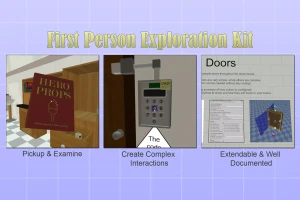
Impostors - Runtime Optimization
Converts distant complex 3D objects into simple 2D quads which significantly reduces triangles and drawcalls. Purely runtime. No baking, no preprocessing, just seamless execution.
When creating big worlds it's important to show users large-scale scenes with lots of objects in the background. That's a tough task that requires optimizing shaders, materials, meshes, and so on.
With the help of Impostors, you can greatly simplify this task!
Impostor - fake object(quad), that tries to look like its original object. It's very cheap to render but with a trade-off between performance and visual quality.
We don't really need high visual quality at distance, because distant objects take tiny space on the screen. That's why there are techniques like LODs.
Impostors expand this approach, and in some cases can completely replace it.
Why impostors?
There are several problems with LODs
- it requires manually creating additional assets for each object - meshes with fewer polygons and materials,
- these additional assets increase build size,
- there might be a noticeable difference between LODs, which pop in and out when player moves.
Poping problem is really hard to solve because it's just the trade-off between performance and visual quality. But with Impostors we can solve the first two issues:
- impostors don't require manually creating additional assets,
- impostors don't increase build size,
- impostors work with stylized custom shading,
- in perfect scenarios impostors look exactly like the original objects.
How impostors work
The concept of impostors is quite simple. We just take a photo of the object from a specific angle, and then show this photo as a sprite instead of the original object. Sprites are super cheap to render: they use special shader without lightning calculation and require only 2 triangles to draw. Whenever camera changes position we need to regenerate the photo to represent object from a new angle.
Important note
Again, we stuck with the trade-off between performance and visual quality.
Impostors are not a panacea and cannot replace standard rendering.
But it provides the opportunity to fill your scene with lots of distant details if your project fits several conditions.
When to use impostors
Before we continue with this chapter I want to mention: if you have any doubts or questions about impostors working with your project, feel free to contact me with some gameplay footage or at least a high-level overview of what is going on in your game. I will try my best to answer your questions and let you know whether Impostors fits your project.
Last note, Asset Store provides refunds, and I have never rejected refund requests, so you are covered.
1. Camera rarely changes position
The best scenario for impostors!
Regenerating impostor's image is a rendering operation, which we are trying to avoid as much as possible. When camera doesn't move we don't need to update anything.
Genres: VR with teleportation movement or steady gameplay, visual novels, side-scrollers.
2. First-person character camera
Works perfectly with impostors!
Genres: open-world FPS, battle-royal, survivals.
3. Flying or top-down camera
Such camera behavior requires constantly regenerating photos of impostors, which leads to way less performance boost. However, I can't say that impostors cannot be used in such games! Example scene shows exactly that scenario.
4. Fast-paced camera movement
The weak part of impostors.
Games like racing and flying simulators might not work with impostors as good as others. It depends on what you are trying to achieve. Feel free to contact me and we will try to understand whether your project works with impostors or not.
5. Games with procedural objects
If your game has procedurally generated meshes, I doubt you have LODs for them:)
In such a situation Impostors package comes handy because it generates everything at runtime!
6. Low-poly games
It depends on the platform you targeting and the count of objects you want to present in your scene. Generally speaking, impostors are overkill for games with a low poly count.
Limitations
- Requires shaders that support forward rendering and RGBA ColorMask.
- Whenever lighting condition changes impostors' images need to be updated.
- At a close distance it's quite easy to distinguish impostor from the original object, so they must be used at most at 10% of camera screen size.
- For now, Impostors doesn't support semi-transparent objects. Only Opaque and AlphaTest/Cutout shaders.
- For now, Impostors supports only one directional light plus ambient light.
Features:
- Significant decrease in poly and drawcall counts
- Works with stylized custom shading
- No asset pre-processing, no baking
- No additional assets
- Doesn't increase build size
- Generates everything at runtime
- Fast setup
- Multiple cameras
- VR (tested with Oculus Quest)
- Utilizes max performance using Jobs and Burst
- Supports moving objects
Dependencies:
- Unity 2020.3.16 - 2023.1.X
- Burst
- Mathematics
- Collections
Supported Render Pipelines:
- Built-in
- Universal
- It may be used in custom RP (requires a bit of coding to embed impostors into RP)
- NO OFFICIAL SUPPORT FOR HDRP
Supported platforms:
Every platform that supports render textures, which is almost every platform supported by Unity.
WebGL is an exception because it doesn't work with the multithreading Jobs System.
Technical details
Supported Unity versions:
- 2020.3.16+ LTS
- 2021.3 LTS
- 2022.3 LTS
- 2023.1
Dependencies:
- Unity 2020.3.16f1
- Burst
- Mathematics
- Collections
Supported Render Pipelines:
- Built-in
- Universal
- It may be used in custom RP (requires a bit of coding to embed impostors into RP)
- NO OFFICIAL SUPPORT FOR HDRP
Lightning Limitations:
- Any count of baked lights
- Only one realtime directional light
- No realtime or mixed non-directional lights
Supported platforms:
Every platform that supports render textures, which is almost every platform supported by Unity.
WebGL is an exception because it doesn't work with the multithreading Jobs System.









